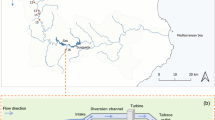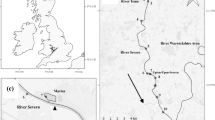Abstract
Flume experiments were carried out to examine whether larval blackflies (Simulium ornatum complex, Diptera: Simuliidae) use microhabitats with a highvelocity current to reduce the risk of predation by some of their main predators, viz. larvae of the stoneflies Isoperla grammatica and Diura nanseni (Plecoptera: Perlodidae), and the caddis-fly Rhyacophila nubila (Trichoptera: Rhyacophilidae). We exposed blackfly larvae to four different current velocities and measured their feeding rate using dye particles. The maximum feeding rate was recorded at intermediate velocities (18.8 and 36.2 cm/s), whereas at low (7.3 cm/s) and high (53.3 cm/s) velocities, the feeding rate was reduced. In separate experiments, we investigated the behaviour and attack success of the different predator species. The two perlodids showed a similar hunting behaviour, which was significantly less successful at higher velocities. Drift of the perlodids from the experimental arena resulted in reduced encounter and attack rates, especially in I. grammatica, which had completely lost efficiency at 36.2 cm/s. R. nubila had a slower mode of hunting and was unaffected by current speed within the velocity gradient studied. Drift in Rhyacophila was rare. Observations on the behaviour of blackfly larvae were performed in the same experiments. The larvae showed no apparent ability to sense the presence of the predators except when these disrupted the flow pattern or were in physical contact, which often resulted in aggressive defence, though without effect on the predators. Escape of blackfly larvae by drift did occur, but this was no more common than being captured. In a current velocity gradient, blackfly larvae showed a weak preference for increasing velocities. Thus, at velocities between 7 and 54 cm/s, blackfly larvae appear to select microhabitats with high current velocities, despite a reduction in feeding optimality, thereby easing the predation impact from perlodids, though not from Rhyacophila. The study demonstrates the importance of microhabitat selection by blackfly larvae both for efficient feeding and predator avoidance.
Similar content being viewed by others

References
Allan JD, Flecker AS, McClintock NL (1987) Prey preference of stoneflies: sedentary vs mobile prey. Oikos 49: 323–331
Chance JM, Craig DA (1986) Hydrodynamic and behaviour of Simuliidae larvae (Diptera). Can J Zool 64: 1295–1309
Charpentier B, Morin A (1994) Effect of current velocity on ingestion rates on black fly larvae. Can J Fish Aquat Sci 51: 1615–1619
Ciborowski JJH, Craig DA (1991) Factors influencing dispersion of larval black flies (Diptera: Simuliidae): effects of the presence of an invertebrate predator. Can J Zool 69: 1120–1123
Craig DA, Galloway MM (1987) Hydrodynamics of larval black flies. In: Kim KC, Merritt RW (eds) Black flies: ecology, population management, and annotated world list. Pennsylvania State University Press, University Park, pp 172–185
Crosskey RW (1990) The natural history of blackflies. Wiley, Chischester
Davies DM (1981) Predators upon blackflies. In: Laird M (ed) Blackflies: the future for biological methods in integrated control. Academic Press, London, pp 139–158
Englund G (1991) Asymmetric resource competition in a filterfeeding stream insect (Hydropsyche siltalai; Trichoptera). Freshwater Biol 26: 425–432
Hansen RA, Hart DD, Merz RA (1991) Flow mediates predatorprey interactions between triclad flatworms and larval balck flies. Oikos 60: 187–196
Hart DD (1987) Processes and patterns of competition in larval black flies. In: Kim KC, Merritt RW (eds) Black flies: ecology, population management, and annotated world list. Pennsylvania State University Press, University Park, pp 109–128
Hart DD (1992) Community organization in streams: the importance of species interactions, physical factors, and chance. Oecologia 91: 220–228
Hart DD, Merz RA, Genovese SJ, Clark BD (1991) Feeding posture of suspension-feeding larval black flies: the conflicting demands of drag and food acquisition. Oecologia 85: 457–463
Kurtak DC (1978) Efficiency of filter feeding of black fly larvae (Diptera: Simuliidae). Can J Zool 56: 1608–1623
Lacoursière JO (1992) A laboratory study of fluid flow and microhabitat selection by larvae of Simulium vittatum (Diptera: Simuliidae). Can J Zool 70: 582–596
Lacoursière JO, Craig DA (1990) A small flume for studying the influence of hydrodynamic factors on benthic invertebrate behaviour. J North Am Benthol Soc 9: 358–367
Lacoursière JO, Craig DA (1993) Fluid transmission and filtration efficiency of the labral fans of black fly larvae (Diptera: Simuliidae): hydrodynamic, morphological, and behavioural aspects. Can J Zool 71: 148–162
Malmqvist B (1994) Preimaginal blackflies (Diptera: Simuliidae) and their predators in a central Scandinavian lake outlet stream. Ann Zool Fenn 31: 245–255
Malmqvist B, Sjöström P (1984) The microdistribution of some lotic insect predators in relation to their prey and to abiotic factors. Freshwater Biol 14: 649–656
Malmqvist B, Sjöström P, Frick K (1991) The diet of two species of Isoperla (Plecoptera: Perlodidae) in relation to season, site, and sympatry. Hydrobioligia 213: 191–203
Morin A, Back C, Chalifour A, Boisvert J, Peters RH (1988a) Effect of black fly ingestion and assimilation on seston transport in a Quebec lake outlet. Can J Fish Aquat Sci 45: 705–714
Morin A, Back C, Chalifour A, Boisvert J, Peters RH (1988b) Empirical models predicting ingestion rates of black fly larvae. Can J Fish Aquat Sci 45: 1711–1719
Muotka T, Penttinen A (1995) Detecting small-scale spatial patterns in lotic predator-prey relationships: statistical methods and a case study. Can J Fish Aquat Sci 51: 2210–2218
Neill WE (1992) Population variation in the ontogeny of predatorinduced vertical migration of copepods. Nature 356: 54–57
Petersen A (1924) Bidrag til de danske Simuliers Naturhistorie. K Dan Vidensk Selsk Skr 5: 237–339
Phillipson J (1956) A study of factors determining the distribution of the blackfly Simulium ornatum Mg Bull Entomol Res 47: 227–238
Pijanowska J (1993) Diel vertical migration in zooplankton: fixed or inducible behaviour? Arch Hydrobiol Beih Erg 39: 89–97
Poff NL, Ward JV (1995) Herbivory under different flow regimes: a field experiment and test of a model with a benthic stream insect. Oikos 72: 179–188
Sheldon AL, Oswood MW (1977) Blackfly (Diptera: Simuliidae) abundance in a lake outlet: test of a predictive model. Hydrobiologia 56: 113–120
Sih A (1987) Predators and prey life-styles: an evolutionary and ecological overview. In: Kerfoot WC, Sih A (eds) Predation: direct and indirect impacts on aquatic communities, University Press of New England, Hanover, Pa
Tikkanen P, Muotka T, Huhta A, Juntunen A (in press) The roles of active predator choice and prey vulnerability in determining the diet of predatory stonefly (Plecoptera) nymphs. J Anim Ecol
Wiley MJ, Kohler SL (1981) An assessment of biological interactions in an epilithic stream community using time-lapse cinematography. Hydrobiologia 78: 183–188
Wotton RS (1987a) Lake outlet blackflies-the dynamics of filter feeders at very high population densities. Holarct Ecol 10: 65–72
Wotton RS (1987b) The ecology of lake-outlet black flies. In: Kim KC, Merritt RW (eds) Black flies: ecology, population management, and annotated world list. Pennsylvania State University Press, University Park, pp 146–154
Wotton RS, Malmqvist B, Ashelford K (1995) The retention of particles intercepted by a dense aggregation of lake-outlet suspension feeders. Hydrobiologia 306: 125–129
Wotton RS, Joicey CP, Malmqvist B (1996) Spiralling of particles by suspension feeders in a small lake-outlet stream. Can J Zool 74:758–761
Zhang Y, Malmqvist B (in press) Relationships between labral fan morphology and habitat in north Swedish blackfly larvae (Diptera: Simuliidae). Biol J Linn Soc
Author information
Authors and Affiliations
Corresponding author
Rights and permissions
About this article
Cite this article
Malmqvist, B., Sackmann, G. Changing risk of predation for a filter-feeding insect along a current velocity gradient. Oecologia 108, 450–458 (1996). https://doi.org/10.1007/BF00333721
Received:
Accepted:
Issue Date:
DOI: https://doi.org/10.1007/BF00333721



